You may not find this terribly rewarding unless you're included here, so this is a good time for casual and random browsers to turn back before they get too caught up in the sweep and majesty of the proceedings and can't let go.
Artistically, the subject invites a tension between the going-through-the-motions of artistic technique and familiarity of the required elements of the scene, on the one hand, and, on the other, some special emotional oomph on the part of the artist.
First, Judith and Holofernes
The baseline for comparisons is here:

The flyer for an exhibition of Artemisia Gentileschi in the Palazzo Reale in Milan (across from the Duomo), November 2011. The exhibition was 'No Photo!' but this provides the baseline from which other Judith-and-Holofernes pictures can be measured. (It is thought that the Judith is modeled on Artemisia herself, providing an extra layer of interest, and speculation.)

A lifeless beheading by Veronese, in the Palazzo Rosso, Genoa, February 2012

A fresco in the Monastery of San Salvatore and Civic Museum in Brescia, December 2013

A fresco in the Trento Castle, Alto Adige, December 2013

An ecstatic moment, by Guido Cagnacci, ca. 1640, in the Pinacoteca Nazionale in Bologna, May2014

A little more discomfort on the part of Holofernes in this one, attributed to Teofilo Trufamonti, 17th century, in the Galleria Nazionale di Parma, housed in the Palazzo della Pilotta in Parma. Trufamonti is best known for a Judith and Holofernes picture, but it's not this one. February 2016.

Nerves of steel on this furtive Judith, by Lionello Spada of Parma, ca. 1618, also in the National Gallery in the Palazzo della Pilotta in Parma, February 2016

Lots of interesting movement in this one by the wonderful Lavinia Fontana (1552-1614), in the Pinacoteca Stuard, Parma, February 2016.

A perfunctory Judith and Holofernes by Giuseppe Vermiglio, ca. 1620, in the Palazzo Chiericati in Vicenza, May 2016

Judith and a reminder about Holofernes (the obligatory nurse is the only interesting part of the picture) by Alessandro Tiarini, Lavinia Fontana's godson, 17th century, in the pinacoteca in Padua, March 2017

A pleased-looking Judith -- compared to Artemisa for emotional force, on a 1-10 scale this one, by Giovan Pietro Gnocchi, from Milan in the late 16th century, gets a 1. ("Look what I found!"). In the Pinacoteca Civica in the Palazzo Volpi, Como, February 2018

Artemisia's most famous work is her Judith and Holofernes, but this isn't it. This is by the Flemish Ludovicus Finton or Finsonius (ca. 1580/85-1617), who worked in Naples from ca.1606 to ca.1613. It's not bad, though. In the Museo di Capodimonte in Naples, viewed in October 2023
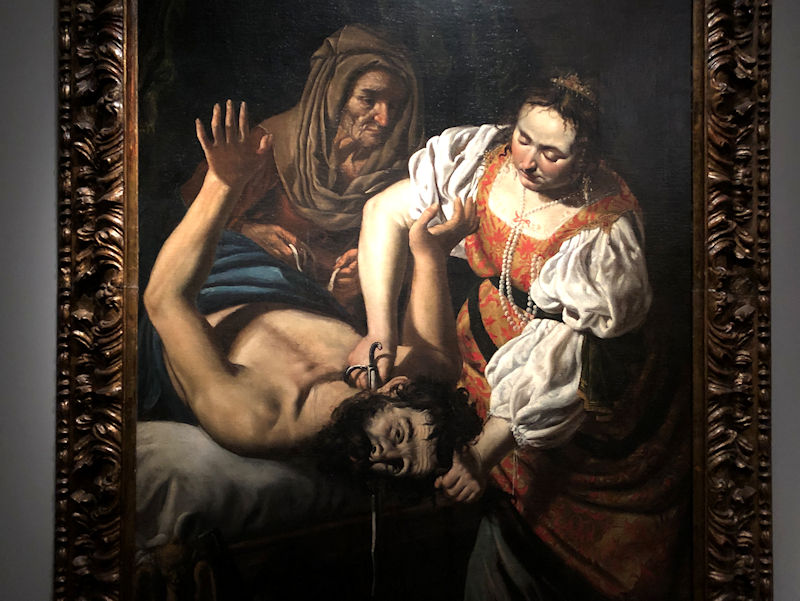
Another Judith and Holofernes, with a workmanlike Judith but less blood from Holofernes, by Biagio Manzoni, a Caravaggeschi from Faenza. In the Museo di Capodimonte in Naples, viewed in October 2023
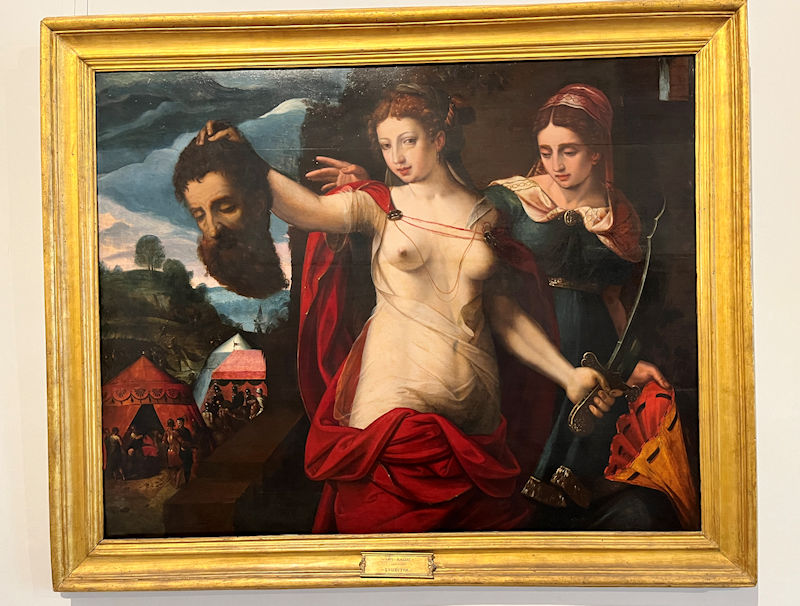
This is a rather uninspired Judith and Holofernes by Jan Massijs or Matsys, unlike some of his funny Flemish-style domestic scenes, but since we have this collection of beheading pictures, chiefly to compare with Artemisia Gentileschi, Caravaggio, and other favorites, we'll include this coy mistress here. In the Palazzo Barberini, Rome, October 2024

Caravaggio's contribution to the Judith Beheading Holofernes canon, done in about 1600. This is one of the best in the genre, but it's hard not to consider Artemisia Gentileschi's version to be the best one. In the Palazzo Barberini, Rome, October 2024
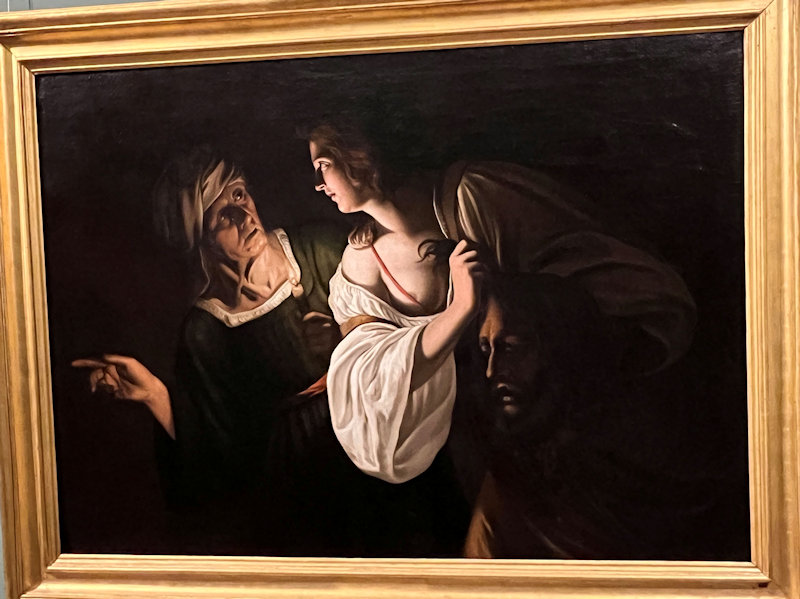
A classic Judith and Holofernes, and not a bad one at all, by Gerard Seghers (1591-1651), who worked in Rome and Naples in his 20s, influenced by Caravaggio's fans there, but returned to Antwerp by 1620 for the rest of his life. In the Galleria Corsini, Rome, October 2024
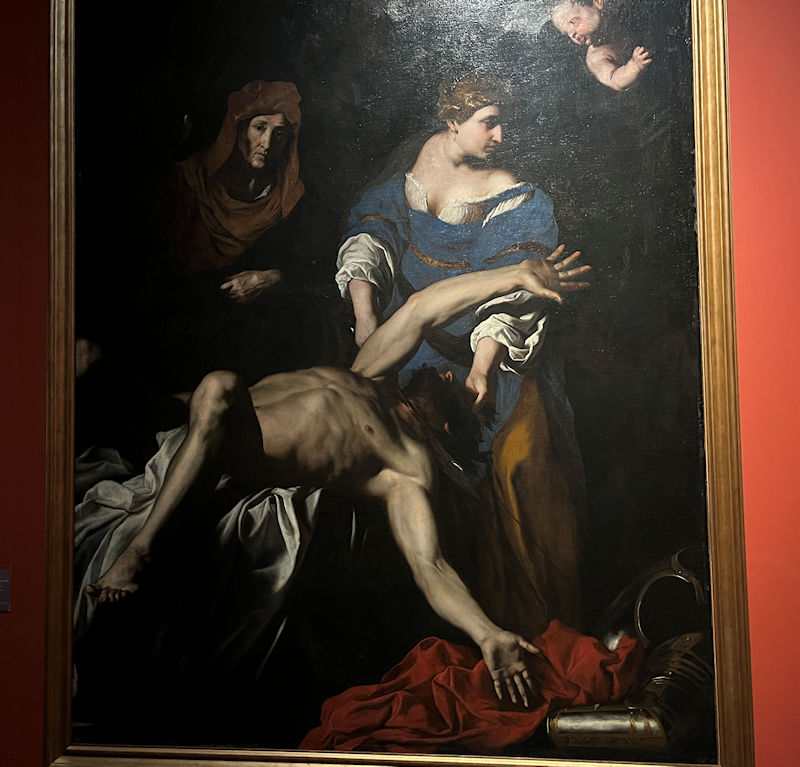
One does relish a good 'Judith decapitating Holofernes' (a fad, we've been told, that may have been inspired by the execution of Beatrice Cenci in 1599), and this one is not bad, except for the unconcerned look on the nurse's face and the baby inexplicably hanging from the ceiling (who's actually a cherub or something who's been cropped off the photo). It's by Pietro Novelli in 1637.
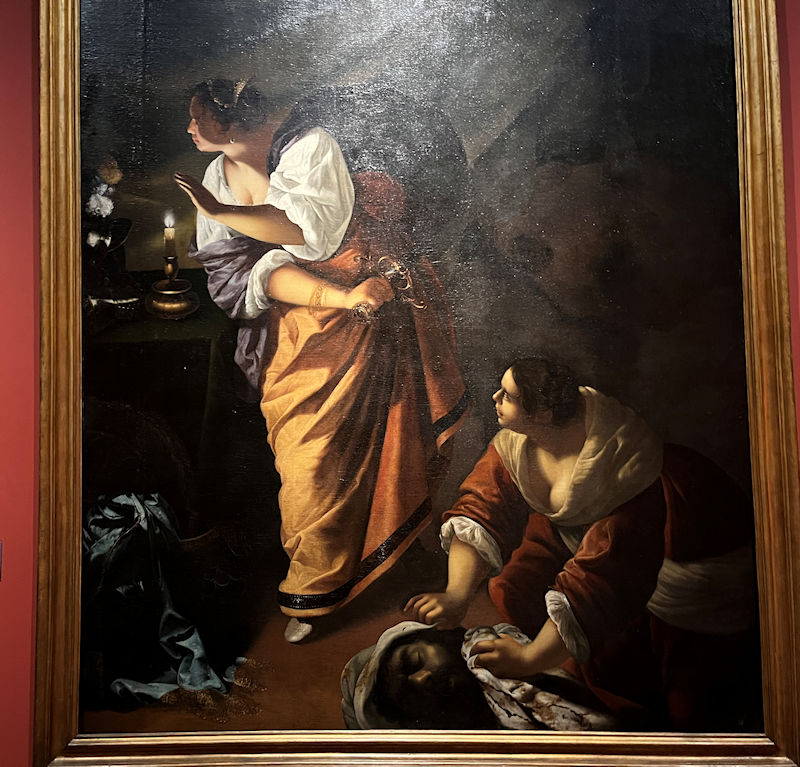
Back to the big leagues now: 'Judith and her Maid Abra with the head of Holofernes', 1645-1650, by Artemisia Gentileschi, Museo di Capodimonte, October 2024

And still another 'Giuditta e Oloferne', dated to 1653-1659, by Mattia Preti, who evidently worked for most of his life in Naples. Capodimonte, 2024.
Next, Salome and John the Baptist

A pleasant Salome, by Matthias Stomer from the Netherlands, working in Italy in the early-mid 17th century; in the Palazzo Bianco in Genoa, February 2012

A dynamic 'Salome and John the Baptist' with scarcely any Salome in it, by il Morazzone (Pier Francesco Mazzucchelli, 1573-1626) (who also worked on the Sacro Monte of Varallo and the one in Orta). Also in Genoa's Palazzo Bianco.

A crazy Salome who's not content with just a beheading, by Giovanni Andrea Ansaldo of Genoa (1584-1638), in the Palazzo Bianco, February 2012

A bored and disinterested Salome ('-- Thanks, just drop it on my tray'), by Bernardino Luini (ca.1482–1532) in the Louvre in Paris, April 2012

In the Prato cathedral, November 2014

Salome at a discreet distance; by Daniele da Volterra, 1551, in the Sabauda Gallery in Torino, December 2015

'Well done, young man, you can go now'; by Lionello Spada, early 17th century, in the Palazzo della Pilotta in Parma, February 2016
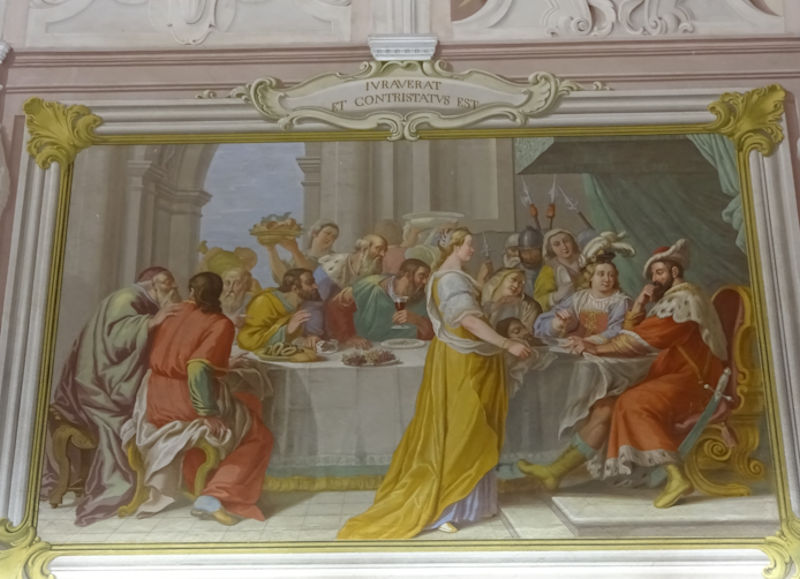
An odd fresco in the monks' refectory of the Certosa di Calci (or Certosa di Pisa) in Calci, near Pisa, November 2016

What looks like the original of the fresco just above, this by Rubens, ca. 1638, in the Civic Museum and pinacoteca in the Chiesa di Santa Caterina, Treviso, March 2017

A obvious attempt to implicate us viewers in the crime, in the Civic Museum of Padua, by Bernardo Strozzi of Genoa, a childhood Capuchin monk who, condemned by his superiors for his secular commissions, decided to leave the order in 1630 and got stuck in jail for it. He showed up in Venice a few years later, flourished, and died in there in 1644.

A remarkably (perhaps pathologically) composed Salomé with John the Baptist's head, by Cranach the Elder, ca. 1515, in the Museu Nacional de Arte Antiga, Lisbon, Portugal, November 2017

'Thanks. Go see my dad, he'll settle your bill.' By Guercino (Giovanni Francesco Barbieri ), 17th century, in the Museo della Città in Rimini, December 2017

A classic beheading of St John the Baptist, with a dog who doesn't care, in the Incoronata in Lodi, Lombardy, February 2018

This is rather disappointing, but it's attributed to Simon Vouet so we can't pass it up: 'Herodias with the Head of St John the Baptist'. She was supposedly the wife of Herod Antipas and allegedly talked her daughter Salome into dancing before Herod to get him to have the Baptist beheaded. In the Galleria Corsini in Rome, October 2024

'Salome with the Head of John the Baptist', by Guido Reni, dated 1630-1635. In the Galleria Corsini in Rome, October 2024

'Beheading of Saint John the Baptist', c.1564, by Marco Pino (aka Marco da Siena, 1521-1583)
Finally, of course, David and Goliath

-- This isn't that kind of party, David. You'll have to leave your friend outside. (In the Museo di Capodimonte, Naples, viewed November 2010)

Another party for the red-headed Biblical hero, by Matteo Rosseli, ca. 1620s, in the Louvre, Paris, April 2012

A boy with a large feather on, and a head, by Guido Reni, ca. 1605, in the Louvre, April 2012

Bringing the huge head indoors, by an 'Unknown Painter Active in Rome, ca. 1650', in the Palazzo Farnese, Piacenza, November 2015

Another party for David, by
Francesco Allegrini da Gubbio (1587-1663) in Federico III da Montefeltro's Palazzo Ducale in Gubbio, November 2015

A soporific David and Goliath, surprisingly by Orazio Gentileschi in the late 16th century, in Federico III da Montefeltro's real Ducal Palace, in Urbino, November 2015

Another very laid-back Goliath beheading, this also by Guido Reni, early 17th century (like he just found this on the driveway and is wondering who put it there). Also in the Palazzo Ducale in Urbino, 2015.
A few bonus tracks

The beheadings and behaloings of Sts Damian and Cosmas, by Fra Angelico, ca. 1440, in the Louvre in Paris [2012]

Perseus and Medusa (presumably) in the Palazzo Reale in the Via Balbi, Genoa [2012]

This lurid extract from a larger picture by Philippe de Champaigne (ca. 1660) commemorates the brothers St Gervais and St Protais (sons of Saints Vital and Valérie), martyred by Nero but dug up by St Ambrose in 386 and translated to Milan, in the Musée des Beaux Arts in Lyon, France. [viewed in 2013]
----------

Aficionados of beheading pictures (Holofernes, John the Baptist, Goliath, etc.) will rejoice in Caron's Massacres under the Triumvirate (1566) -- heads lined up on the benches, chasing people all over ancient Rome, waving heads around like party favors. (In the Louvre, Paris)

And passing heads along hand-to-hand like an assembly line. The painting commemorates various massacres of Huguenot Protestants by the Duc de Guise and his Catholic friends, not in Rome but in Paris, Vassy, and elsewhere in 1561-2 (nothing like what happened a few years later, in 1572, on St Bartholomew's Day in Paris).
 Dwight
Peck's personal website
Dwight
Peck's personal website













































